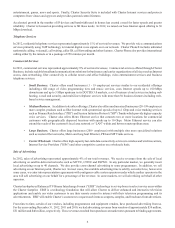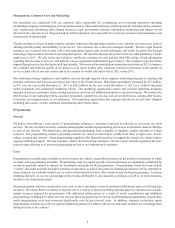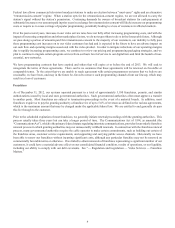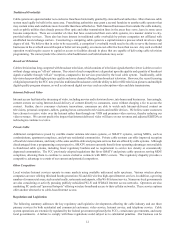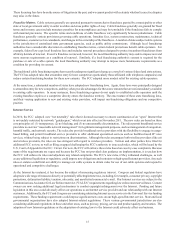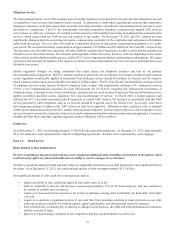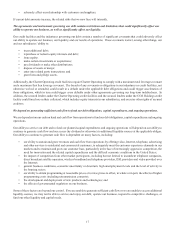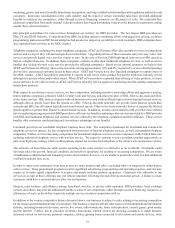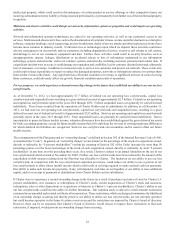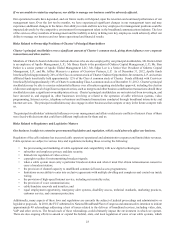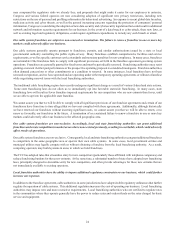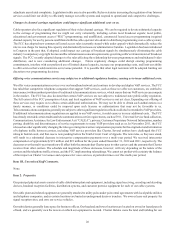Charter 2012 Annual Report Download - page 28
Download and view the complete annual report
Please find page 28 of the 2012 Charter annual report below. You can navigate through the pages in the report by either clicking on the pages listed below, or by using the keyword search tool below to find specific information within the annual report.16
Telephone Service
The Telecommunications Act of 1996 created a more favorable regulatory environment for us to provide telecommunications and/
or competitive voice services than had previously existed. In particular, it established requirements ensuring that competitive
telephone companies could interconnect their networks with those providers of traditional telecommunications services to open
the market to competition. The FCC has subsequently ruled that competitive telephone companies that support VoIP services,
such as those we offer our customers, are entitled to interconnection with incumbent providers of traditional telecommunications
services, which ensures that our VoIP services can compete in the market. On November 18, 2011, the FCC released an order
significantly changing the rules governing intercarrier compensation payments for the origination and termination of telephone
traffic between carriers. The new rules will result in a substantial decrease in intercarrier compensation payments over a multi-
year period. We received intercarrier compensation of approximately $19 million and $23 million in 2012 and 2011, respectively.
The decreases over the multi-year transition will affect both the amounts that Charter pays to other carriers and the amounts that
Charter receives from other carriers. The schedule and magnitude of these decreases, however, will vary depending on the nature
of the carriers and the telephone traffic at issue, and the FCC's new ruling initiates further implementation rulemakings. We cannot
yet predict with certainty the balance of the impact on Charter's revenues and expenses for voice services at particular times over
this multi-year period.
Further regulatory changes are being considered that could impact our telephone business and that of our primary
telecommunications competitors. The FCC and state regulatory authorities are considering, for example, whether certain common
carrier regulations traditionally applied to incumbent local exchange carriers should be modified or reduced, and the extent to
which common carrier requirements should be extended to VoIP providers. The FCC has already determined that certain providers
of telephone services using Internet Protocol technology must comply with requirements relating to 911 emergency services
(“E911”), the Communications Assistance for Law Enforcement Act ("CALEA") regarding law enforcement surveillance of
communications, Universal Service Fund contribution, customer privacy and Customer Proprietary Network Information issues,
number portability, disability access, regulatory fees, and discontinuance of service. In March 2007, a federal appeals court
affirmed the FCC’s decision concerning federal regulation of certain VoIP services, but declined to specifically find that VoIP
service provided by cable companies, such as we provide, should be regulated only at the federal level. As a result, some states
have begun proceedings to subject cable VoIP services to state level regulation. Although we have registered with, or obtained
certificates or authorizations from, the FCC and the state regulatory authorities in those states in which we offer competitive voice
services in order to ensure the continuity of our services and to maintain needed network interconnection arrangements, it is unclear
whether and how these and other ongoing regulatory matters ultimately will be resolved.
Employees
As of December 31, 2012, we had approximately 17,800 full-time equivalent employees. At December 31, 2012, approximately
60 of our employees were represented by collective bargaining agreements. We have never experienced a work stoppage.
Item 1A. Risk Factors.
Risks Related to Our Indebtedness
We have a significant amount of debt and may incur significant additional debt, including secured debt, in the future, which
could adversely affect our financial health and our ability to react to changes in our business.
We have a significant amount of debt and may (subject to applicable restrictions in our debt instruments) incur additional debt in
the future. As of December 31, 2012, our total principal amount of debt was approximately $12.9 billion.
Our significant amount of debt could have consequences, such as:
• impact our ability to raise additional capital at reasonable rates, or at all;
• make us vulnerable to interest rate increases, because approximately 13% of our borrowings are, and may continue to
be, subject to variable rates of interest;
• expose us to increased interest expense to the extent we refinance existing debt, particularly our bank debt, with higher
cost debt;
• require us to dedicate a significant portion of our cash flow from operating activities to make payments on our debt,
reducing our funds available for working capital, capital expenditures, and other general corporate expenses;
• limit our flexibility in planning for, or reacting to, changes in our business, the cable and telecommunications industries,
and the economy at large;
• place us at a disadvantage compared to our competitors that have proportionately less debt; and


